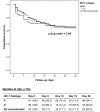Enrichment of HIV-1 subtype AD recombinants in a Ugandan cohort of severely septic patients
- PMID: 23144755
- PMCID: PMC3483180
- DOI: 10.1371/journal.pone.0048356
Enrichment of HIV-1 subtype AD recombinants in a Ugandan cohort of severely septic patients
Abstract
Background: Several population-wide HIV-1 subtype distribution studies in Uganda have evaluated relatively healthy clinic patients. Given the differences in HIV-1 disease progression based on subtype, we examined HIV-1 subtype distribution and disease outcomes among hospitalized patients with severe sepsis.
Methods: Patients with severe sepsis were enrolled at two hospitals in Uganda. Data collected included demographics, Karnofsky scores, highly active antiretroviral therapy (HAART) use, HIV-1 serostatus, CD4+ T cell concentration, whole blood lactate concentration, and blood cultures. HIV-1 subtypes were determined by sequencing parts of the gag and env genes, followed by phylogenetic analysis.
Results: Of the 267 patients evaluated, 228 (85.4%) were HIV infected. The predominant HIV-1 subtypes were A (46%), D (17%), and AD recombinants (30%). HIV-1 subtypes B, C, and other recombinants were uncommon. Patients infected with HIV-1 subtypes A, D and AD viruses were similar in demographics, CD4(+) T cell concentration, HAART use, Karnofsky scores, whole blood lactate concentration, and positive blood cultures. There was no difference in 30-day mortality from severe sepsis between the 3 groups (p = 0.99).
Conclusion: A high proportion of HIV-1 subtypes A and AD recombinants was observed in this cohort of severely septic patients. The proportion of AD recombinants was higher in this cohort than in previous cohorts of Ugandan HIV-1 patients. No difference in baseline demographics, clinical factors or 30-day mortality was seen across HIV-subtypes.
Conflict of interest statement
Figures



References
-
- Taylor BS, Hammer SM (2008) The challenge of HIV-1 subtype diversity. N Engl J Med 359: 1965–1966. - PubMed
-
- Brennan CA, Lund JK, Golden A, Yamaguchi J, Vallari AS, et al. (1997) Serologic and phylogenetic characterization of HIV-1 subtypes in Uganda. AIDS 11: 1823–1832. - PubMed
-
- Gale CV, Yirrell DL, Campbell E, Van der Paal L, Grosskurth H, et al. (2006) Genotypic variation in the pol gene of HIV type 1 in an antiretroviral treatment-naive population in rural southwestern Uganda. AIDS Res Hum Retroviruses 22: 985–992. - PubMed
Publication types
MeSH terms
Substances
Grants and funding
LinkOut - more resources
Full Text Sources
Medical
Research Materials

